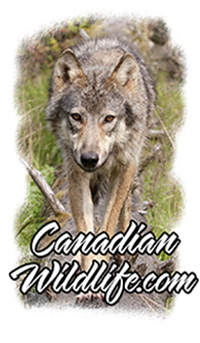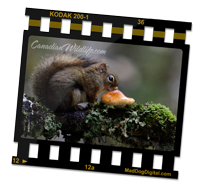 |
|
| |
|
Welcome to Canadian Wildlife |
| |
| Wildlife in
Canada |
Copyright notice: All text, layout,
images and graphical representations are copyright ©
2010
Mad Dog
Digital and may not be copied, reproduced or
transmitted without the written consent of
Mad Dog
Digital. Please contact us for more information.
|
|
Details about:
The Red
squirrel |
| |
 Introducing: The
Red squirrel Introducing: The
Red squirrel
Like a flash, the happy-go-lucky Red Squirrel zips
along the forest floor and bounds up an evergreen
tree in apparent defiance of the laws of gravity.
Walking through the forest, you are suddenly
bombarded by the chattering scolding of the Red
Squirrel. You’ve just entered his territory!
Measuring 11” - 15” (27 - 40 cm) long including
their 3½” - 6” (9 - 15 cm) long fluffy tail, the Red
Squirrel is a unending packet of energy. Their
lightweight bodies, weighing 5 - 7 oz (140 - 200 gr),
are propelled along the forest floor and bound up
tree trucks by their 1½” - 2” (40-06 cm) long hind
feet.
Red Squirrels, as evident by their name, have a
rusty-red to grayish-red upper body and a white to
whitish-gray belly. Their tail is the same color as
their upper body and is banded by a wide black band
with a fine white outline. Occasionally they can be
found in a mainly black coloration and even rarer in
a white variation.
The Red Squirrel feeds primarily on conifer cones
and seeds. Great piles of cone remnants (called
middens) measuring up to 40” (1 m) across can be
seen sprawled on the forest floor under branches of
coniferous trees. In addition to conifer cones, they
are also know to eat acorns, fungi, various seeds
including those from maple, elm tulip and hickory,
but appear to have a gourmet’s touch when it comes
to truffles and mushrooms. Clipped and collected,
these truffles and mushrooms are often placed in
tree branches where they can dry out before being
stored away for the winter.
As if their entire summer is spent preparing for
winter, Red Squirrels spend almost every waking
minute eating conifer cones and seeds and building a
winter cache. Nests are built in hollowed trees,
fallen trees and even in ground burrows. Winter food
is stored in these forest locations along with green
conifer cones that are collected and stored in damp
earth, or in the middens, to provide winter food.
Red Squirrels generally have a vague idea where they
hid their food caches, but they usually have to run
around hunting and searching to find them back
again. |
| |
 |
| |
With winter food caches keeping them fed, late
winter signals courtship and the search for a mate.
Courtship involves high-speed, high-adrenalin, very
excited and animated chases. These courtship chases
are witnessed as flashes of small animals with
fluffy tails running through the forest, across the
snow and bounding up tree trunks. Between March and
April, a litter of 3 - 7 young are born. Born pink,
hairless and weighing only 0.3 oz (10 gr) the baby
Red Squirrels rely completely on their mother for
the next 40 days. After 40 days these juveniles may
emerge from the nest, but will continue nursing
until 2½ months old. After 4 months they have
reached full size and are ready top leave the nest.
In order for a juvenile red squirrel to survive the
first winter, it is imperative that they find a
territory with a midden. Between the time of the
last litter and the courtship the previous winter
mothers may have acquired additional territories and
middens. If one of her juveniles is unsuccessful in
claiming its own territory, it has been seen that
mothers have given part of their territory and
middens to this juvenile.
Outside of this rare ritual of giving away
territory, Red Squirrels actively defend their
territories year-round against other Red Squirrels
as well as intruders who are quickly admonished with
a serving of their incessant chattering. These
territories, with several nesting sites and food
caches throughout, are the red Squirrel’s lifeblood
to surviving the elements and seasons.
Return to our main animals in
Canada page |
| |
 |
|
|
|
|



